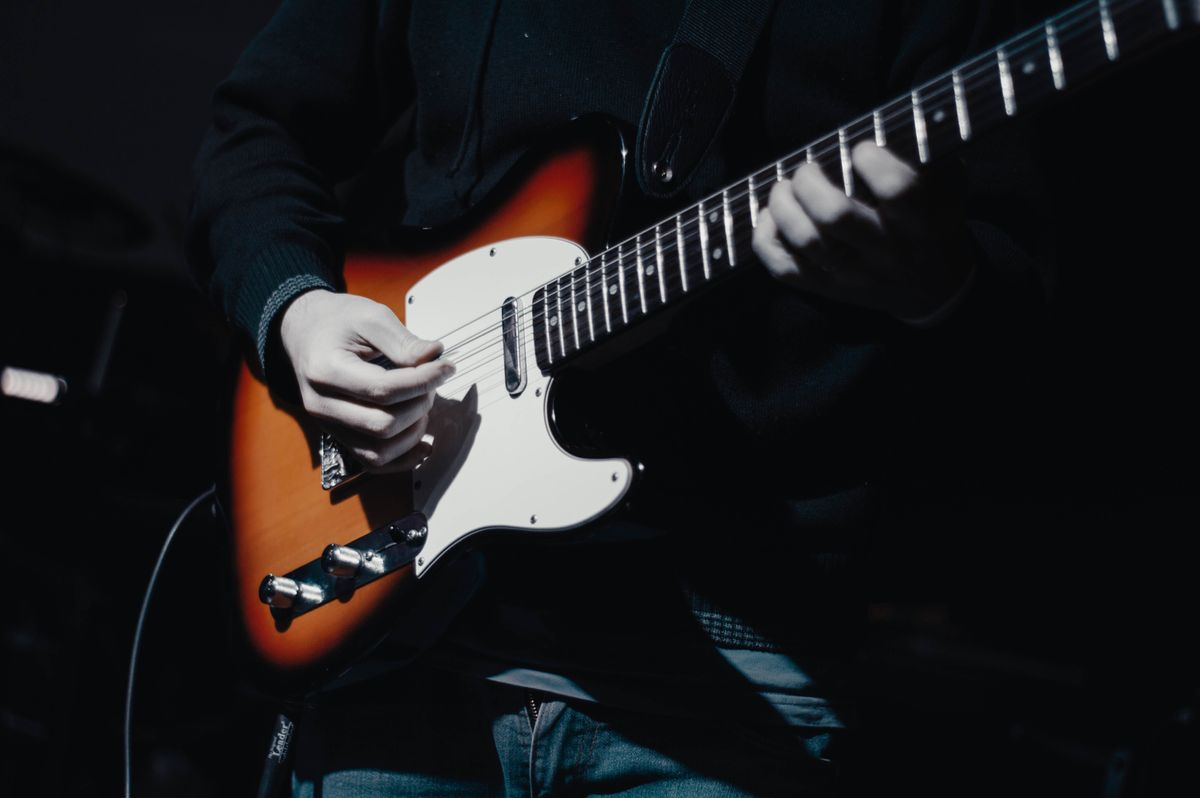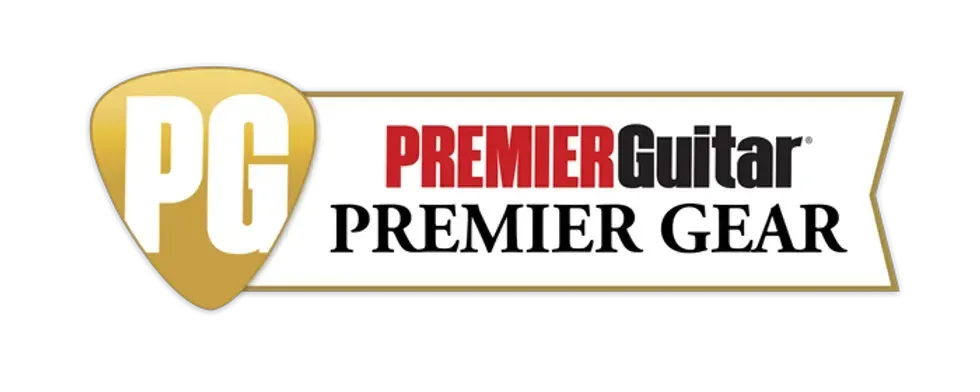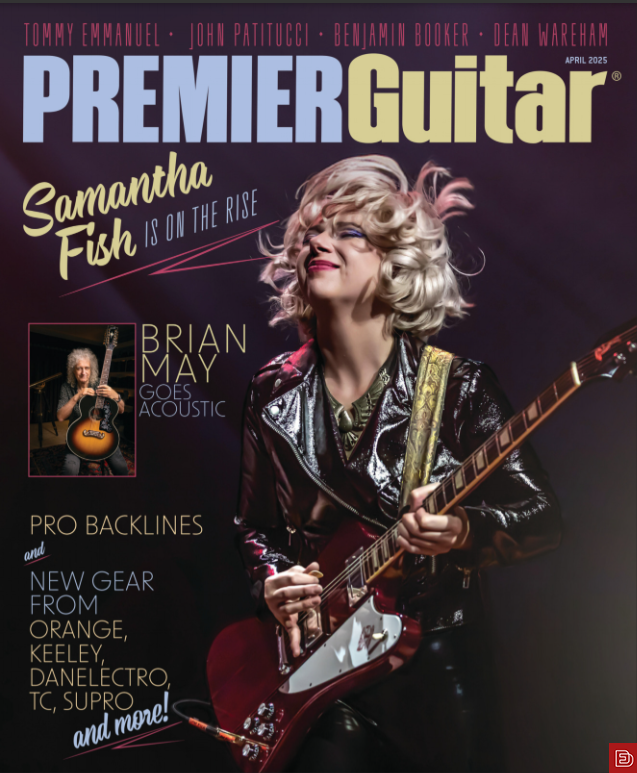
This crash course in country guitar will inject your rock and blues playing with a brand-spankin’ new spark.
The key that unlocks the door to country guitar is hybrid picking—simultaneously or alternately playing notes with both pick and fingers. If you have any experience playing fingerstyle guitar, it’s sure to come in handy here. If not, no worries! Here’s your chance to start. Now, some of the musical examples below can surely be played with a pick only, but the magic is in the snap you get when you pluck the strings with your fingers.
SRV & EVH Bridge the Gap
Let’s ease into hybrid picking with a couple of related examples from the blues and rock world to demonstrate how country techniques can spice up your playing. Inspired by blues legend Albert King, who exclusively played fingerstyle, Stevie Ray Vaughn would unleash stinging notes from his high E string by plucking with his middle finger. First, try playing Ex. 1 with a pick. Then, while holding your pick normally, use the tip of your middle finger to reach under the first string, pulling it away from you, then quickly releasing. This will cause the string to slap against the fret, resulting in a satisfying, biting attack. The final note is picked, but you can try plucking here as well.
Let’s see how it’s done by the man himself, as he sits in with his idol in the following video. Notice how he plucks the first two notes country-style, lending them a sharpness that contrasts so well with the picked notes which follow.
In the music video for Van Halen’s “Finish What Ya Started,” a quasi-country song from 1988’s OU812, Eddie Van Halen dons his cowboy hat (quite literally, as you’ll see in a moment) and masterfully cranks out a classic country-style lick often heard in R&B, blues and rock. It’s one which is dominated by major and minor sixths played on non-adjacent strings. Ex. 2 is along the same lines, and you’ll need to alternately play picked notes on the 3rd string and SRV-style plucked notes on the 1st.
Sure, that sounds okay, but now let’s really countrify it. In Ex. 3, we present the same basic lick, but notice how all of the notes on the 3rd string (except the very first) are now deadened. To achieve this, lightly rest your fret-hand finger on the string at roughly the same locations as in Ex. 2, creating a pitchless, percussive sound, a technique integral to country playing. And be sure to play the 1st-string notes staccato (short) as indicated by the dots above the noteheads. Now you’re beginning to sound like a bona fide country player!
Truck Stops and Double-Stops
Let’s take a gander at country and jazz guitar legend Danny Gatton (once known as “the world’s greatest unknown guitarist”) playing a catchy, hybrid-picked chordal riff.
Ex. 4 takes a similar tack and will have you alternating picked notes and dyads (two-note chords), plucked with your middle and ring fingers. In bars 2 and 4, check out how hybrid picking allows you to continue the groove while simultaneously adding some snappy fills on top.
Let’s continue with that same technique, but with a twist. First, check out British country master Albert Lee playing the main riff to “Bullish Boogie” from his 1986 album Speechless.
Ex. 5 will have you playing a similar type of phrase. After plucking each of the dyads, pull off to the open 3rd string for an added rhythmic bounce—which leads us smack dab into what just might be the most fun you’ll have all day.
Open-String Magic
We’ve just had a small taste of what open strings have to offer. But they’re even more powerful, allowing you to zip up and down the fretboard in dramatic fashion. Brad Paisley is a guru of open strings, as you’ll see here:
Ex. 6 would fit right into Paisley’s wheelhouse. Here, it’s imperative to play the accented notes a little louder. For country pickers, this means to pluck harder with your middle finger, so as to get an even sharper snap. It’s a bit shocking how simply using the open 3rd string as a pivot allows you to shift positions at the speed of light.
Ex. 7 is a similar idea, but this time we’re moving down the fretboard, palm-muting the 5th string to create even more of a contrast between the picked and plucked notes, which are again accented.
Whew! Let’s take a quick break to catch Jerry Donahue of the Hellecasters tearing up the Jerry Reed classic “The Claw.”
Stealing from the Steel-ers
Country pickers love to, shall we say “borrow,” some of pedal steel players’ favorite moves. You likely have already played a host of rock-centric oblique bends—a two-string affair where one note is allowed to ring while the other is bent—allowing you to come close to approximating the sound of a pedal steel. But if you’re new to country guitar, chances are you haven’t encountered anything quite like Ex. 8.
To pull this one off, you’ll need to execute tricky 3rd-string bends with your index finger by pulling the string down towards the floor. Plus you’ll need to do it while fretting the 4th and 5th strings with your pinky and ring finger, respectively. Take a deep breath and go for it.
This last one’s just for extra credit, and it involves countrifying oblique bends with another signature pedal steel move: harp harmonics. First, let’s check out Ex. 9.
To execute these harp harmonics, fret the indicated note as usual. Then you’ll see another number in parentheses located 12 frets above. Next, lightly touch the string with your pick-hand index finger directly over the fret, while holding your pick between your thumb and middle finger. (You can also set down the pick and pluck with your thumb instead.) Finally, strike the string with your pick on the bridge side of your index finger. The result is a shimmering harmonic one octave above the fretted note.
Well, that’s a wrap. If you give yourself some time to experiment with hybrid picking and the fun ideas we covered in this lesson, you’ll invariably hit on some new ones of your own, sure to perk up your rock and blues playing. Finally, Greg Koch, grand master of chicken pickin’ (and pretty much everything else guitar) will fittingly play us out with his unique brand of gristled, country-fried rock.
Well-designed pickups. Extremely comfortable contours. Smooth, playable neck.
Middle position could use a bit more mids. Price could scare off some.
$2,999
Ernie Ball Music Man StingRay II
A surprise 6-string collaboration with Cory Wong moves effortlessly between ’70s George Benson and Blink-182 tones.
Announced at the 2025 NAMM show, Cory Wong’s new collaboration with Ernie Ball Music Man scratched an itch—namely, the itch for a humbucker-loaded guitar that could appease Wong’s rock-and-R&B alter ego and serve as complement to his signature Fender Strat. Inspiration came from no further than a bandmate’s namesake instrument. Vulfpeck bassist Joe Dart has a line of signature model EBMM basses, one of which uses the classic StingRay bass body profile. So, when Wong went looking for something distinctive, he wondered if EBMM could create a 6-string guitar using the classic StingRay bass body and headstock profile.
Double the Fun
Wong is, by his own admission, a single-coil devotee. That’s where the core of his sound lives and it feels like home to him. However, Wong is as inspired by classic Earth, Wind & Fire tones and the pop-punk of the early ’90s as he is by Prince and the Minneapolis funk that he grew up with. The StingRay II is a guitar that can cover all those bases.
Ernie Ball has a history of designing fast-feeling, comfortable necks. And I can’t remember ever struggling to move around an EBMM fretboard. The roasted maple C-shaped neck here is slightly thicker in profile than I expected, but still very comfortable. (I must also mention that the back of the neck has a dazzling, almost holographic look to the grain that morphs in the light). By any measure, the StingRay II’s curves seemed designed for comfort and speed. Now, let’s talk about those pickups.Hot or Not?
A few years ago EBMM introduced a line of HT (heat-treated) pickups. The pickups are built with technology the company used to develop their Cobalt and M-Series strings. A fair amount of the process is shrouded in secrecy and must be taken on faith, but EBMM says treating elements of the pickup with heat increases clarity and dynamic response.
To find out for myself, I plugged the StingRay II into a Fender Vibroverb, Mesa/Boogie Mark VII, and a Neural DSP Quad Cortex (Wong’s preferred live rig). Right away, it was easy to hear the tight low end and warm highs. Often, I feel like the low end from neck humbuckers can feel too loose or lack definition. Neither was the case here. The HT pickup is beautifully balanced with a bounce that’s rich with ES-335 vibes. Clean tones are punchy and bright—especially with the Vibroverb—and dirty tones have more room for air. Individual notes were clear and articulate, too.
Any guitar associated with Wong needs a strong middle-position or combined pickup tone, and the StingRay II delivers. I never felt any significant signal loss in the blended signal from the two humbuckers, even if I could use a bit more midrange presence in the voicing. The midrange gap is nothing an EQ or Tube Screamer couldn’t fix, though. And not surprisingly, very Strat-like sounds were easy to achieve for having less midrange bump.
Knowing Wong’s love for ’90s alt-rock, I expected the bridge pickup to have real bite, and it does, demonstrating exceptional dynamic range and exceptional high-end response that never approached shrill. Nearly every type of distortion and overdrive I threw at it sounded great, but especially anything with a scooped-mid flavor and plenty of low end.
The Verdict
By any measure, the StingRay II is a top-notch, professional instrument. The fit and finish are immaculate and the feel of the neck makes me wonder if EBMM stashes some kind of secret sandpaper, because I don’t think I’ve ever felt a smoother, more playable neck. Kudos are also due to EBMM and Wong for finding an instrument that can move between ’70s George Benson tones and the hammering power chords of ’90s Blink-182. Admittedly, the nearly $3K price could give some players pause, but considering the overall quality of the instrument, it’s not out of line. Wong’s involvement and search for distinct sounds makes the StingRay II more than a tired redux of a classic model—an admirable accomplishment considering EBMM’s long and storied history.
Ernie Ball Music Man StingRay II Cory Wong Signature Electric Guitar - Charcoal Blue with Rosewood Fingerboard
StingRay II Cory Wong - Charcoal Blue
The Melvins' Buzz Osborne joins the party to talk about how he helped Kurt Cobain find the right sounds.
Growing up in the small town of Montesano, Washington, Kurt Cobain turned to his older pal Buzz Osborne for musical direction. So on this episode, we’re talking with the Melvins leader about their friendship, from taking Cobain to see Black Flag in ’84 to their shared guitar journey and how they both thought about gear. And in case you’ve heard otherwise, Kurt was never a Melvins roadie!
Osborne’s latest project is Thunderball from Melvins 1983, something of a side trajectory for the band, which harkens back to this time in Osborne’s life. We dig into that and how it all relates and much more.
In challenging times, sometimes elemental music, like the late Jessie Mae Hemphill’s raucous Mississippi hill country blues, is the best salve. It reminds us of what’s truly essential––musically, culturally, and emotionally. And provides a restorative and safe place, where we can open up, listen, and experience without judgement. And smile.
I’ve been prowling the backroads, juke joints, urban canyons, and VFW halls for more than 40 years, in search of the rawest, most powerful and authentic American music. And among the many things I’ve learned is that what’s more interesting than the music itself is the people who make it.
One of the most interesting people I’ve met is the late Jessie Mae Hemphill. By the time my wife, Laurie Hoffma, and I met Jessie Mae, on a visit to her trailer in Senatobia, Mississippi, she’d had a stroke and retired from performing, but we’d been fortunate to see her years before at the New Orleans Jazz & Heritage festival, where she brought a blues style that was like quiet thunder, rumbling with portent and joy and ache, and all the other stuff that makes us human, sung to her own droning, rocking accompaniment on an old Gibson ES-120T.
To say she was from a musical family is an understatement. Her grandfather, Sid, was twice recorded by Alan Lomax for the Library of Congress. While Sid played fiddle, banjo, guitar, harmonica, keyboards, and more, he was best known as the leader of a fife-and-drum band that made music that spilled directly from Africa’s main artery. Sid was Jessie Mae’s teacher, and she learned well. In fact, you can see her leading her own fife-and-drum group in Robert Mugge’s wonderful documentary Deep Blues(with the late musician and journalist Robert Palmer as on-screen narrator), where she also performs a mournful-but-hypnotic song about betrayal—solo, on guitar—in Junior Kimbrough’s juke joint.
That movie, a 1982 episode of Mr. Rogers’ Neighborhood (on YouTube) where she appears as part of Othar Turner’s Gravel Springs fife-and-drum band, and worldwide festival appearances are as close as Jessie Mae ever got to fame, although that was enough to make her important and influential to Bonnie Raitt, Cat Power, and others. And she made two exceptional albums during her lifetime: 1981’s She-Wolf and 1990’s Feelin’ Good. If you’re unfamiliar with North Mississippi blues, their sound will be a revelation. The style, as Jessie Mae essayed it, is a droning, hypnotic joy that bumps along like a freight train full of happily rattling box cars populated by carefree hobos. Often the songs ride on one chord, but that chord is the only one that’s needed to put the music’s joy and conviction across. Feelin’ Good, in particular, is essential Jessie Mae. Even the songs about heartbreak, like “Go Back To Your Used To Be” and “Shame on You,” have a propulsion dappled with little bends and other 6-string inflections that wrap the listener in a hypnotic web. Listening to Feelin’ Good, it’s easy to disappear in the music and to have all your troubles vanish as well—for at least as long as its 14 songs last.“She made it clear that she had a gun—a .44 with a pearl handle that took up the entire length of her handbag.”
The challenge I’ve long issued to people unfamiliar with Jessie Mae’s music is: “Listen to Feelin’ Good and then tell me if you’re not feeling happier, more cheerful, and relaxed.” It truly does, as the old cliché would have it, make your backbone slip and your troubles along with it. Especially uptempo songs like the scrappy title track and the charging “Streamline Train.” There’s also an appealing live 1984 performance of the latter on YouTube, with Jessie Mae decked out in leopard-print pants and vest, playing a tambourine wedged onto her left high-heel shoe––one of her stylish signatures.
Jessie Mae was a complex person, caught between the old-school dilemma of playing “the Devil’s music” and yearning for a spiritual life, sweet as pecan pie with extra molasses but quick to turn mean at any perceived slight. She also spent much of her later years in poverty, in a small trailer with a hole in the floor where mice and other critters got in. And she was as mistrustful of strangers as she was warm once she accepted you into her heart. But watch your step before she did. On our first visit to her home, she made it clear that she had a gun—a .44 with a pearl handle that took up the entire length of her handbag and would make Dirty Harry envious.
Happily, she took us into her heart and we took her into ours, helping as much as we could and talking often. She was inspiring, and I wrote a song about her, and even got to perform it for her in her trailer, which was just a little terrifying, since I knew she would not hold back her criticism if she didn't like it. Instead, she giggled like a kid and blushed, and asked if I’d write one more verse about the artifacts she’d gathered while touring around the world.
Jessie Mae died in 2006, at age 82, and, as happens when every great folk artist dies, we lost many songs and stories, and the wisdom of her experience. But you can still get a whiff of all that––if you listen to Feelin’ Good.
Intermediate
Intermediate
How David Gilmour masterully employs target notes to make his solos sing.
When I was an undergraduate jazz performance major struggling to get a handle on bebop improvisation, I remember my professor Dave LaLama admonishing me, “If you think playing over the fast tunes is hard, wait until you try playing over the ballads. What Dr. Lalama was trying to impart was that playing fast scales over fast changes could get you by, but playing melodically over slow tempos, when your note choices are much more exposed, would really test how well you could create meaningful phrases.
Although getting past the “this scale works over these chords” approach to improvisation generally requires hours of shedding, aiming for particular target notes (specific notes over specific chords) is an optimum strategy to maximize your practice time. In the realm of rock guitar, I can think of no greater master of the melodic target note technique while playing ballads than David Gilmour.
For the unfamiliar few, Gilmour was first enlisted by fledgling psychedelic rockers Pink Floyd in 1967, when original guitarist/vocalist Syd Barrett began having drug-induced struggles with mental health. The band experimented with various artistic approaches for several years before refining them into a cohesive “art rock” sound by the early ’70s. The result was an unbroken streak of classic, genre-defining conceptual albums that included Meddle, The Dark Side of the Moon, Wish You Were Here, Animals, and The Wall. Although bassist/vocalist Roger Waters assumed the role of de facto bandleader and primary songwriter, Gilmour was a significant contributor who was praised for his soulful singing and expertly phrased lead playing that seemed to magically rework pedestrian blues phrases into sublimely evocative melodies. His focus on musicality over excessive displays of technique made him a musician’s musician of sorts and earned him a stellar reputation in guitar circles. When Roger Waters left Pink Floyd in the mid ’80s, Gilmour surprised many by calmly assuming the leadership mantle, leading the band through another decade of chart-topping albums and stadium tours. Although Pink Floyd are not officially broken up (keyboardist and founding member Richard Wright died in 2008 while Gilmour and drummer Nick Mason joined forces with Ukrainian singer Andriy Khlyvnyuk on the one-off single “Hey Hey Rise Up” in 2022), Gilmour has mostly spent the last few decades concentrating on his solo career. His latest release, Luck and Strange, features his wife, novelist Polly Sampson, as primary lyricist and daughter Romany Gilmour as vocalist on several tracks. His recent tour filled arenas around the world.
Let’s take a page from Gilmour’s hallowed playbook and see how incorporating a few well-chosen target notes can give our playing more melody and structure.
For the sake of simplicity, all the examples use the Gm/Bb major pentatonic scale forms. In my experience as a teacher, I find that most students can get a pretty solid handle on the root-position, Form-I minor pentatonic scale but struggle to incorporate the other four shapes while playing lead. One suggestion I give them is to work on playing the scales from the top notes down and focus on the four highest strings only. I believe this is a more logical and useful approach to incorporating these forms into your vocabulary. Try playing through Ex. 1, Ex. 2, Ex. 3, and Ex. 4, which are based on the top-down approach of the Form I, Form II, Form IV, and Form I (up an octave) shapes respectively.
Ex. 1
Ex. 2
Ex. 3
Ex. 4
Once you’ve gotten a handle on the scales, try playing Ex. 5, which is loosely based on the extended introduction to Pink Floyd’s “Shine On You Crazy Diamond.” We begin by soloing over a static Gm chord for four measures. As target notes, I’ve chosen the root and 5th of the G minor chord ( the notes G and D, respectively). In the first measure, we’re starting in a minor pentatonic Form I with a bend up to the root of the Gm chord. A flurry of notes on beat 4 sets us up for the bend to the D in the second measure. The D note is again targeted in measure three—this time up an octave via a shift into the minor pentatonic Form II shape. Measure four aims for the G tonic up an octave, but ends with a bend that targets a C—the root of the IVm (Cm) chord in the final measure. By focusing on target notes and connecting them with embellishing licks, your lead lines will have a much better sense of direction and melodic narrative. Also, by only targeting the root and 5th of the chord, the target note approach will be easily transferrable to songs in a G blues context (G pentatonic minor over a G major or G dominant tonality).
Ex. 5
A further exploration of this approach, Ex. 6 begins with a two-beat pickup that resolves to the scale tonic G. This time however, the G isn’t serving as the root of the Im chord. Instead, it’s the 5th of Cm—the IVm chord. Employing the root of the pentatonic scale as the fifth of the IVm chord is a textbook Gilmour-ism and you can hear him use it to good effect on the extended intro to “Echoes” from Live in Gdansk. When approaching the C on beat 2 of the second full measure, bend up from the Bb on the 6th fret of the 1st string then slide up to the C on the 8th fret without releasing the bend or picking again. In the final measure, I’ve introduced two Db notes, which serve as the b5 “blue note” of the scale and provide melodically compelling passing tones on the way to the G target note on beat 4.
Ex. 6
Exclusively positioned in the Form-IV G minor pentatonic shape, Ex. 7 is based on a bluesy lick over the I chord in the first and third measures that alternately targets a resolution to the root of the IV chord (C ) and the root of the V chord (D7#9) in the second and fourth measures. Being able to resolve your lead phrases to the roots of the I, IV, and V chords on the fly is an essential skill ace improvisers like Gilmour have mastered.
Ex. 7
Now let’s turn our attention to the Bb major pentatonic scale, which is the relative major of G minor. Play through the Form I and Form II shapes detailed in Ex. 8 and Ex. 9 below. You’ll see I’ve added an Eb to the scale (technically making them hexatonic scales). This allows us a bit more melodic freedom and—most importantly—gives us the root note of the IV chord.
Ex. 8
Ex. 9
Channeling the melodic mojo of Gilmour’s lead jaunts on Pink Floyd’s “Mother” and “Comfortably Numb,” Ex. 10 targets chord tones from the I, IV, and V (Bb, Eb, and F) chords.
The muted-string rake in first measure helps “sting” the F note, which is the 5th of the Bb. Measure two targets a G note which is the 3rd of the Eb. This same chord/target note pairing is repeated in the third and fourth measures, although the G is now down an octave. For the F and Eb chords of measures five and six, I’ve mirrored a favorite Gilmour go-to: bending up to the 3rd of a chord then releasing and resolving to the root (an A resolving to an F for the F chord and a G resolving to an Eb for the Eb chord.) The final measure follows a melodic run down the Bb scale that ultimately resolves on the tonic. Be sure to pay attention to the intonation of all your bends, especially the half-step bend on the first beat of measure seven.
As a takeaway from this lesson, let’s strive to “Be Like Dave” and pay closer attention to target notes when soloing. Identify the roots of all the chords you’re playing over in your scales and aim for them as the beginning and/or ending notes of your phrases. Think of these target notes as support beams that will provide structure to your lead lines and ultimately make them more melodically compelling.






